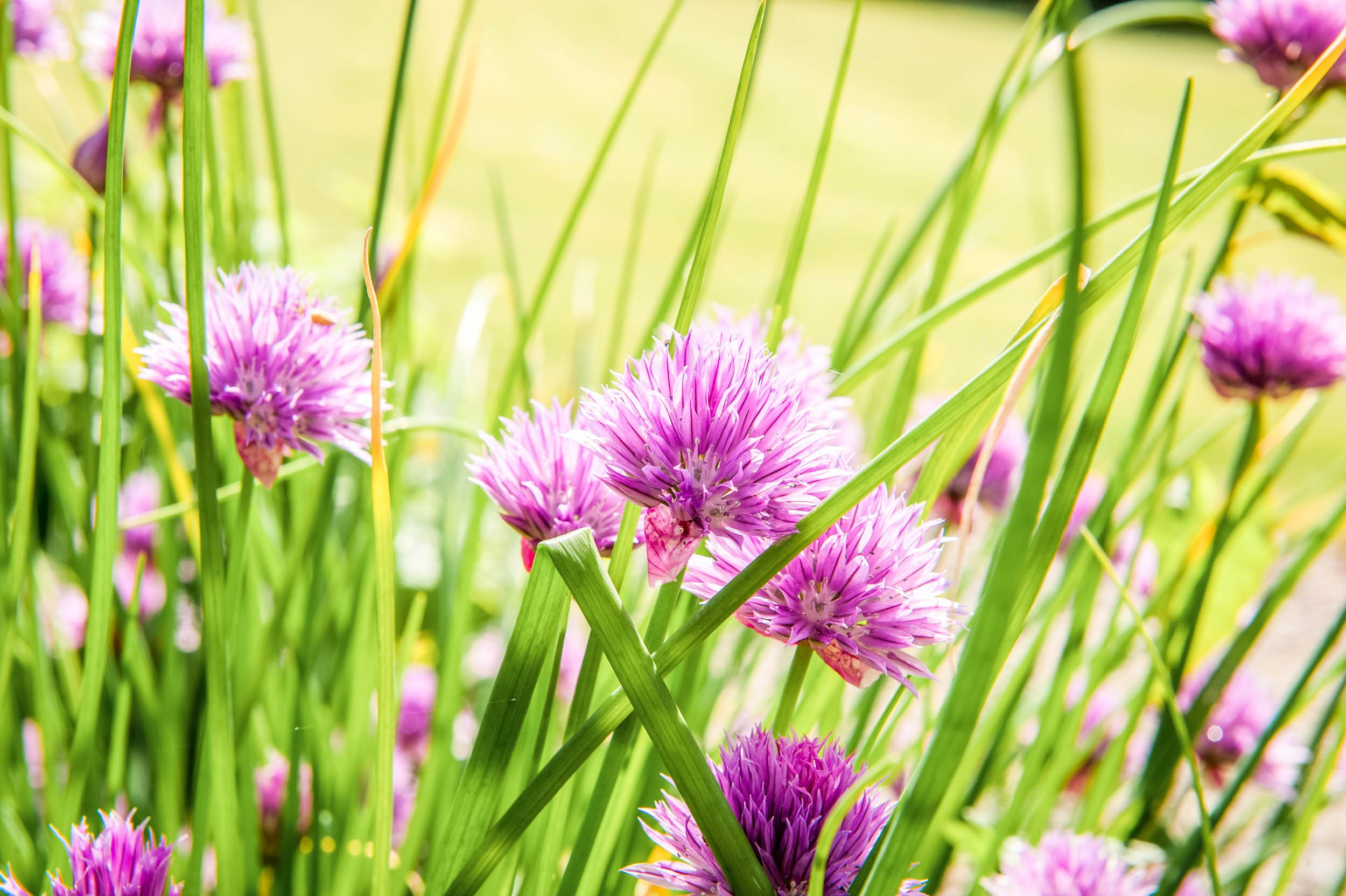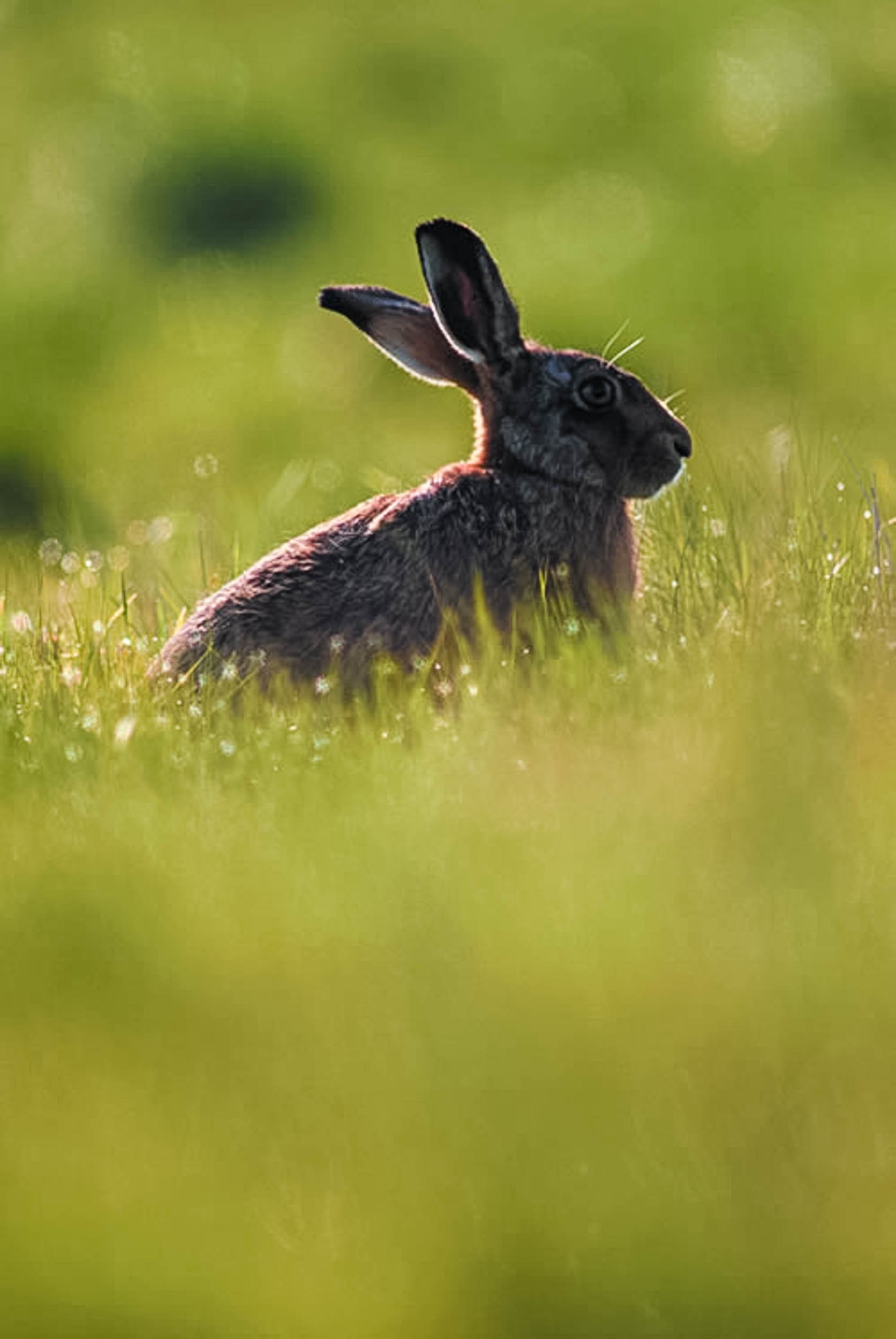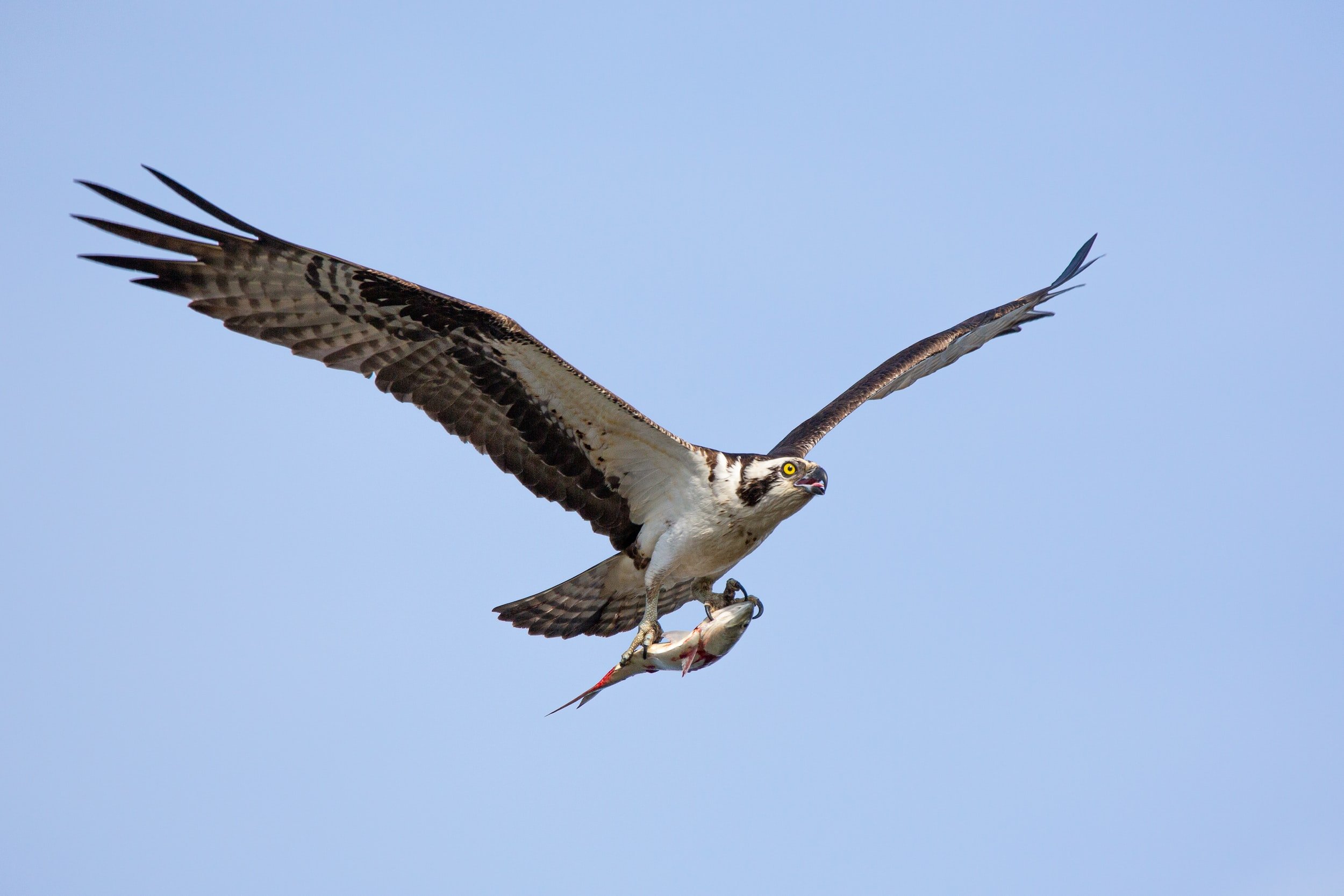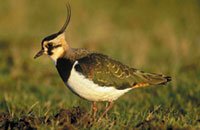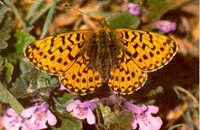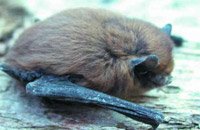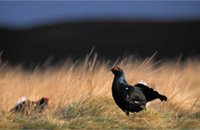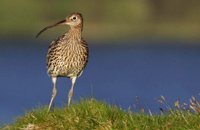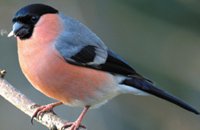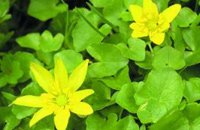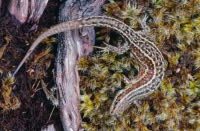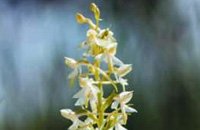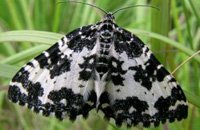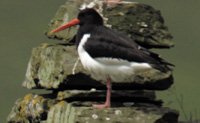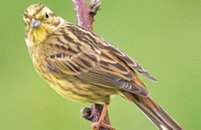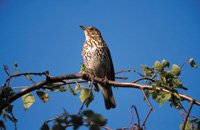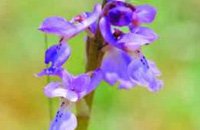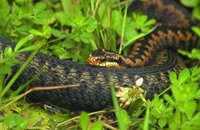
Lowlands & Farmlands
(Picture: Drymen)
Nature in Loch Lomond & The Trossachs
The list below will introduce you to some of the wildlife to be found in the Park’s lowlands and farmland. There are also links to other websites where you can find out more. The landscape may be less dramatic, but the plants and animals to be found here are just as beautiful, rare and special, and often a lot easier to see!
South of the Highland Boundary Fault, the great geological rift that straddles the National Park, the landscape is soft and rolling, a dramatic contrast to the mountains and glens to the north. Here you’ll find pastureland and arable fields framed by hedges and drystane dykes, narrow winding lanes and tiny patches of woodland. It’s a great place for young families to go for a bike ride, or for a gentle stroll. It’s also a great place for wildlife spotting – a brown hare darting across an open field, a skylark singing high up above your head, butterflies and delicate wildlflowers nestled under a hedgeline.
-
Latin name: Lepus europaeusalt
Size: Length 48 - 70cm
Where: Stoneymollan; between Gartocharn and Balloch in the pasture fields; Balmaha Marshes NNR in winter
When: All year round, but easier to see in spring, and at dawn and dusk
Some people find it hard to distinguish between a brown hare and a rabbit. Think of it as the difference between a Ferrari and a family saloon and you won’t go far wrong. Hares are bigger, longer, sleeker and much faster than rabbits – reaching speeds of up to 30mph if disturbed or threatened. If you get a closer look you will see that their ears and tails are tipped with black, a smart and racy contrast to their tawny red-brown fur.
You are most likely to see a hare in rough grassland or arable fields at dawn or dusk when they venture out to feed. They are shy creatures and hunker down in shallow dips or ‘forms’ during the day to hide from predators like golden eagles.
In spring thay lose some of their shyness in their eagerness to find a mate, so it’s a good time to look out for them. If you see a pair ‘boxing’ it is likely to be a female telling a male in no uncertain terms that she is not yet ready to receive his advances!
Find out more at:
-
Latin name: Vanellus vanellusalt
Length: 28 - 31cm Wingspan: 70 – 76cm
Where: Glen Dochart and other lower mountain slopes and upland farmland areas.
When: All year round, but best sightings in spring and early summer
A lapwing in flight is unmistakable once you learn to pick out its dark, paddle-round wings and bouncy way of flying. If you see them from a distance in fields and pasture land they look like small, jaunty black and white birds – but a closer look reveals metallic shimmers of dark green and magenta in their wings, and a feathery crest that quivers in the breeze. For most of the year they gather together, sometimes flying in tight flocks over the fields, flashing all white or all dark as they change direction as one.
In spring they sound as if they are whooping with happiness at the returning warmth. Their joyful calls fill the air as they perform their aerial mating displays. Pairs whirl, twist and dive together, sealing the bond between them before the female makes her nest in a scrape of ground. Their habit of nesting in arable fields has led to a steep decline in their numbers as more and more farmers plough or combine before the young have time to fledge. They can often be seen near water-logged fields or shallow, muddy pools.
If you see what looks like an injured bird as you walk through the fields in spring and summer don’t be too quick to call the vet. If the adult lapwing feels its nest or young are threatened it may try to distract an intruder by pretending to be injured, calling piteously or dragging its wing. This has led to the bird’s curious collective name – a ‘deceit’ of lapwings.
Find out more at:
-
Latin names: Boloria euphrosyne
Wingspan: 40 - 60mm
Where: Slopes with violets, bare ground and shallow bracken. (SPBF) Damp grassy areas with violets.
When: (PBF) May to mid June; (SPBF) Late May to early August
Unless you are a butterfly expert – or have very keen eyesight – you’ll be hard-pressed to tell these two species apart. But what’s important is that they are both striking and beautiful butterflies – chequerboards of orange, cream and brown reminiscent of 1930s china.
You are most likely to catch a glimpse of them as they dance around bright green patches of fresh, young violets – their caterpillars’ foodplant. The adult pearl-bordered fritillaries emerge from their chrysalis in early May. Their small cousins are a little shyer, waiting until late May to reveal their true colours in most years.
Both species of butterfly have declined dramatically in England over the last 50 years. This is because many woodland owners no longer manage their land by coppicing on a regular basis, making their woodlands too dark for the wildflowers to grow. Scotland is the butterflies’ main UK refuge now, though even here they are under threat. The charity, Butterfly Conservation Scotland, is doing all it can to halt their decline, and will be keen to hear about any butterflies you may see.Small pearl-bordered fritillary
If you do want to tell them apart, try to get a good look at the butterfly’s underwing. Small pearl-bordered fritillaries have several silver-white patches across the middle of the wing – while pearl-bordered fritillaries only have two.
Find out more at:
https://www.butterfly-conservation.org/scotland
-
Latin name: Alauda arvensis
Size: Length 18-19cm
Where: Any open grassland or moors
When: All year round, but most noticeable on warm, sunny days
You are far more likely to hear a skylark than to see it. For many people their liquid song captures the essence of a warm summer day, drifting down from high in the sky. Look up and all you will see is a black dot against the blue. If you are not sure what it sounds like go to the RSPB’s website where you can hear a piece of its lovely music.
If you do see a skylark up close you’ll find it’s a buff brown, streaky bird – some might say dull – with a small, jaunty crest which it raises when alarmed. Bigger than a blue tit, smaller than a blackbird, it has a flight like a Harrier jump jet – lifting straight up into the air as high as 1000ft to sing. Once there it can sing for up to an hour, advertising its territory to keep other skylarks at bay.
Find out more at:
-
Latin name: Vipera berusadder
Length: Males up to 60cm, females up to 75cm
Weight: Males 50 - 60gm, females 80 - 100gm
Where: Glen Dochart; Loch Ard Forest
When: Daytime, spring and summer
The knowledge that there might be a poisonous snake lurking in the undergrowth makes some people nervous of walking in adder country. But these beautiful reptiles deserve our respect, rather than our fear. Though their bite is serious and painful only ten people have died from adder bites in the last 100 years.
Like all reptiles they are cold-blooded. They need the warmth of the sun to give them the energy to hunt and move. So the best time to spot an adder is on a sunny spring morning when they come out to bask in warm, sheltered spots. Woodland banks, heathery moorland and boggy hummocks are good places to try. The clear, zig-zag pattern along their backs warns away potential predators, and helps us tell them apart from the harmless grass snake (though you are unlikely to see a grass snake in Scotland).
Adders are only active once the temperature climbs above 9C, so in Scotland they only come out of hibernation for a short season between about April and October. During this time they need to shed their old skin, mate, and find enough food to keep them alive until the following spring. Their diet consists mainly of small rodents and lizards, which they kill with their venom before swallowing whole. Surprisingly an average adder only needs the equivalent of nine voles a year to survive. Once the temperature dips again in autumn they head back to their hibernation sites, following the scent trails of other adders, with whom they will share their winter bed.
-
Latin name: Orchis mascula
Height: 30-40cmEarly purple orchid
Where: Woods, grassy road verges and meadows; for example Inchcailloch; many places along National Cycle Route 7
When: Flowers late April and May
It is always exciting to find an orchid, because they seem such an exotic flower to find in our Scottish countryside. Early purple orchids are perhaps an especially welcome discovery both because they are the first of the year, and because they are easier than most to find.
Their tall, pinky-purple flower spikes appear at the same time as our bluebells – sometimes in the same woodland – though you are often just as likely to find them in meadows or roadside verges. The flowers have a distinctive smell – described as reminiscent of tom cats! This may explain their old Scots name, ‘Deil’s foot’. Or it may be that people believed the Devil’s footprints made the purple-black markings on the leaves, which distinguish them from most other orchids. Only common spotted orchids share the spotted leaves. But these don’t bloom until June, and have a much tighter, pyramid of flowers at the top of the stem.
Like all orchids they are protected by law, making it illegal to pick them or dig up their roots. If you were able to dig one up you would see why they are called orchids – the Latin word means ‘testicles’. The twin bulbs at their base were believed to be aphrodisiacs in the past!
-
Latin name: Tyto alba
Length: 33 - 39cm Wingspan: 85 – 93cm
Where: Often on the wooded fringes of long grassland
When: Dawn and dusk
Dawn and dusk are the best times to catch sight of this most enigmatic of birds. You may see a flash of white in your headlights as you drive home along a country lane, or watch a pale shape slide silently across the fields as you take your dog for an early morning walk. They are hunting for small mammals hiding in the long grass. The beautiful heart-shaped face is there for a purpose - it helps direct the slightest sounds into their ears, ensuring that they can pinpoint the tiniest rustle of a vole or mouse creeping through the undergrowth. Especially soft feathers on their wings muffle the sound of their own flight so that unsuspecting prey are unaware of their approach.
However, they have a piercing shriek when communicating with each other, which you’ll sometimes hear from your bed in the depths of the night. They nest, as their name suggests, in barns and other outbuildings, church towers, and even hollow trees. The conversion and demolition of many of these old farm buildings is one reason they are much scarcer than in the past. Special nest boxes are now put up in the Park to encourage barn owls to begin breeding again.
Find out more at:
-
Latin name: Pipistrellus
Length: 3.5 - 4.5cm (body) Wingspan: 19 - 25cm
Weight: 3 - 8g
Where: Balmaha Visitor Centre; Milarrochy Bay Building; most wooded roadways in the park
When: Dusk
If you see a bat flitting around a street light or dodging in and out of the moonlit trees at dusk it's likely to be a pipistrelle. These tiny animal-dynamos – the smallest bats in Europe – weigh the same as a teaspoon of sugar. Yet dipping and darting through the air on their tissue-thin wings they can catch up to 3000 moths, gnats and other insects in a night.
In winter they hibernate in buildings, caves and hollow trees because insects are hard to come by. They usually emerge in April to catch the first of their newly-hatched prey. Although they prefer to fly at dusk you can sometimes catch sight of them during the day in quiet woodland glades.
Scientists have recently discovered that pipistrelle bats are actually divided into two species. The newly discovered species is slightly smaller than our common pipistrelle and sends out its echo-location sounds at a slightly higher frequency. They have called it the soprano pipistrelle (Pipistrellus pygmaeus), because of this.
-
Latin name: Pandion haliaetus
Length: 55 - 69cm Wingspan: 145 - 160cm
Where: Lake of Menteith; Loch Lomond NNR and the southern basin area of Loch Lomond area around Balmaha
When: April to October
It’s only in the last 20 years that we’ve been able to see ospreys in the National Park. Persecution drove them to extinction in the UK during the last century. They started returning to breed in the Highlands of Scotland in the 1950s, thanks to the efforts of a dedicated group of conservationists. The birds are now spreading out across other parts of the country where fish are plentiful and they can find undisturbed nesting sites.
Ospreys are summer visitors, flying from the heat of African spring to nest in our cool Scottish climate. Come autumn they fly south again to escape our cold Northern winters. They mate for life, returning with their mate year after year to the same nest site, mostly perched high in a pine, or other sturdy, tall, tree.
They are our only birds of prey that feed solely on fish. Although they are about the size of a buzzard, that’s where the similarities end. Ospreys are slim, elegant birds in flight, with long, narrow, almost gull-like wings. Hunting over a loch, they will hang on the air with slow, languid wingbeats, legs dangling ready to plummet into the water to snatch an unwary pike or trout. You may see one carrying a fish back to its nest – carefully holding it parallel to its body to reduce the drag as it flies. It’s mostly the male that does the hunting, especially when the chicks are small, while the female stays at the broad, twiggy nest to feed and protect her brood.
Find out more at:
www.rspb.org.uk
-
Latin name: Tetrao tetrix
Length: 40 - 55cm Wingspan: 65 - 80cm
Where: Woodland edges and clearings, for example at Cashel
When: Early mornings in spring are the best time to catch a glimpse of them lekking
Although the male black grouse is as big as a domestic hen it is not a bird we often see. Not only because they are they becoming increasingly rare, but also because they hide themselves away in woodland clearings and forest edges. They feed on the seeds, berries and buds they find there - birch buds are particular favourites - and roost high in the trees.
In early spring however the males throw caution to the wind to strut and pose at mating ‘leks’. Sometimes up to a dozen blackcock dandies gather at dawn to display to the females, flaring their scarlet eye wattles, puffing up their neck feathers and fanning their lyre-shaped tails like peacocks. Their strange, dove-like calls can carry across the fields for 400m, alerting any females to the mating game they are playing.
The females are much less striking – they need colours that help them to camouflage their whereabouts when they are incubating eggs or rearing young. Though harder than the males to distinguish from red grouse, their lack of red ‘eyebrows’ or white feathery stockings, and their different taste in habitat, helps distinguish them.
Find out more at:
-
Latin name: Rheumaptera hastata
Wingspan: 30 - 38mm
Where: Flanders Moss NNR, which is just outside the National Park
When: May to early July
The words ‘argent’ and ‘sable’ come from heraldry, meaning ‘silver’ and ‘black’. There is indeed something of the medieval pennant about these dramatic day-flying moths as they flutter across the lowland bogs and damp moorland where they are found.The caterpillars depend on the bog myrtle or young birch saplings that grow in these places for their food and shelter. They ‘spin’ together pairs of leaves to make tiny tents in which they can safely feed and grow, well hidden from birds and other predators.
Argent and sable moths are becoming increasingly rare in England and Wales, but there are many sites in Scotland – including some in and around the National Park – where you still have a chance of seeing these smart pied beauties. Watch out for them on warm, sunny days from May to early July when they are on the wing. If you do see one check that there are no yellow streaks on its body or wings – which would make it a magpie moth.
If it is indeed an argent and sable moth please get in contact with Butterfly Conservation Scotland, which is working to find out where this threatened species can still be found.
Find out more at:
www.butterfly-conservation.org/scotland
-
Latin name: Bombus lapidariusred-tailed bumblebee
When: April to October
Where: Gardens, arable areas, disused railways below 200m
The hum of a bumblebee in your garden is one of the most relaxing sounds of summer. It could be one of a number of different species of bumblebees that favour our gardens and farmland, and play such an important part in pollinating our fruit and wildflowers. Take a close look. If it is black with a foxy-red tail it is likely to be a red-tailed bumblebee.
The first red-tails to emerge in spring are the queens. They are the stay-a-beds of the bumblebee world, waiting for up to a month after the white-tails and buff-tails to wake from their winter hibernation. Once they are up and about they will start to build up a new colony. The first eggs to hatch are her infertile daughters, whose job it is to help to build the hive and feed the new larvae with pollen and nectar.
Later in the summer some of the larvae will become males, while some become new queens. The males do no work around the nest – their job is to mate with the new queens from other nests. Unlike the queens and workers, they have a couple of yellow bands (one broad, one narrow) on the back, and a patch of yellow fur on the face. The males have a raw deal! They do not come back to the security of the nest at night, and can often be found ‘roosting’ underneath flower heads. However, they are excused the duty of collecting nectar and pollen, so spend their days drinking nectar, and looking for new queens. As autumn approaches, the old queen, workers and males die off, while the mated daughter queens find new hiding places underground to sleep away the winter until the whole process can begin again.
-
Latin name: Numenius arquata
Scottish name: Whaup or whapcurlew
Length: 50 - 60cm Wingspan: 80 - 100cm
Where: Glen Dochart; pasture and moorland in summer; muddy coastlines in winter
When: All year round
The curlew’s distinctive long, down-curved bill makes it easy to identify. It uses it to probe deep into the mud or earth to find the invertebrates on which it feeds. From a distance the birds seem a rather drab brown, but a closer look reveals the delicate and complex patterns of brown, black and grey that help them blend into the landscape.
The females are even bigger than the males, and can weigh up to 3lb (1.5kg). Although they do most of the egg brooding, they often head back to their coastal feeding grounds in June, leaving the males to tend the young until they fledge. So if you see a curlew inland late in the summer it’s likely to be a male left holding the baby.
A curlew’s call is one of the most evocative of all our birds – a crescendo of clear, piping notes ending in a bubbling trill. Robert Burns was so moved by it that he wrote:
‘I never heard the solitary whistle of curlew on a summer noon without feeling an elevation of soul.’
You can hear them from early spring in damp fields and moorland all around the Park, where they come to breed. In winter they move back to the muddy estuaries and coastlines where food is more plentiful and easy to come by.
Find out more at:
-
Latin Name: Pyrrhula pyrrhula
Length: 16cm
Where: Inchcailloch; along National Cycle Route 7; in Tyndrum Community woodland; parks and gardens
When: All year round
In winter and spring you often see the rosy glow of a flock of bullfinches hanging like Christmas baubles in the branches of garden shrubs and fruit trees. They are looking for buds – their favourite food – although seeds and berries will do if buds are in short supply. They like to eat their food directly from the branches. You can see their coal-back heads bobbing this way and that as they manipulate the buds to get at the tender centres. Their true habitat is woodland edge and forests, where the only clue to their presence is often the soft whistles and warbles they make as they move through the trees.
Find out more at:
-
Latin name: Turdus philomelos
Length: 23cm
Where: Inchailloch; any woodland or garden
When: All year round
The song thrush is well-named. There are sometimes as many as 100 different phrases in the seemingly endless melodies that it sings from high in the trees. Many people think it one of the most beautiful of our singers. Its song is easily distinguishable from that of the other virtuosos because of its habit of repeating a phrase three or four times before moving on to the next. These birds are also very good mimics, and you may hear the odd ring tone or car alarm in among their more musical phrases.
Most song thrushes stay in the UK all year round, though a number move west from mainland Europe in the winter to escape the cold, and some of our Scottish birds migrate to Ireland, where the weather is milder. They feed on snails, worms and other insects, which are harder to come by in really cold weather. If you see a pile of broken snail shells by a large stone it’s a sure sign that a song thrush has been at work. They are clever birds, smashing the snails on a rock to get at the juicy bodies inside. Like their European cousins the redwings and fieldfares, they also enjoy the autumn harvest of berries. Unlike these other thrushes, which tend to move around in flocks, they are solitary feeders, and if you see a lone, blackbird-sized bird with a soft grey, speckled breast, it’s likely to be a song thrush.
Find out more at:
-
Latin name: Apus apusswift
Length: 16 - 17cm Wingspan: 42 - 48cm
Where: Anywhere other than high mountainous areas, often in villages and towns
When: April to July
The swift is one of our briefest visitors, and all the more precious for that. Their screams are one of the most vibrant sounds of summer, as they swoop into our lives in May like Star Wars fighter jets. Swifts are consummate fliers. It’s not that long ago that some people believed they had no legs and couldn’t land at all. They do eat, sleep and mate on the wing, and land by choice only to lay their eggs and raise their young. It’s been calculated that a seven-year old bird may have flown up to two million kilometres in its lifetime. Swifts mostly nest in building cavities, into which they seem to disappear in the blink of an eye. This leaves them vulnerable to renovation work, and one of the causes of their rapid decline is thought to be the blocking up of historic nest sites.
Their black, scimitar-curved wings help distinguish them from the smaller swallows and martins. Like them they feed exclusively on insects. Our fickle Scottish weather means that they may disappear from our skies for days on end if the weather is wet. Swifts have been known to fly on round trips of up to 1200 miles to find insects beyond a weather depression. Because the chicks’ food source is unreliable they are able to survive without feeding for many days. Their temperature drops and their metabolism slows down until the parents can return with more food.
By early August the chicks have fledged and the family can make the long journey back to Africa for the winter, taking the sounds of summer with them.
-
Latin name: Emberiza citrinella
Length: 16.5cm
Where: Farmland and gardens
Where: All year round; often come to garden feeders in hard weather
Yellowhammers are our sunniest birds. The male’s plumage is almost the lemon-skin yellow of the gorse where they often perch – perhaps for the camouflage it provides. They are birds of arable fields and fence lines, feeding almost exclusively on grass seeds and grains. Sadly, changes in farming practices mean that they are not the common sight they once were.
In autumn and winter you still sometimes see flocks of them milling around field gates, pecking at the spilt grain from the combine harvesters. In spring and summer they leave their flocks to find a mate and pair up. It’s then that the males take to the fence wires to mark out their territories with their unmistakeable song –‘a-little-bit-of-bread-and-no-cheeeeeese.’
Find out more at:
www.rspb.org.uk
-
Latin name: Haematopus ostralegus
Length: 40 - 45cm Wingspan: 80 -86cm
Where: Loch Lomond Shores Car Park in spring and summer; Glen Dochart; Loch Tay head at Killin; coasts in autumn and winter
When: All year round; inland in spring and summer; on coasts in autumn and winter
Despite its name an oystercatcher rarely eats oysters. Instead it uses that long, vermilion beak to prise apart up to 500 cockles and mussels a day. In winter the birds hug the coastline where the ground seldom freezes, so that they can probe the muddy shores for food. Nearly half the mainland European population comes to join our resident birds for the winter, swelling their total numbers to over 300,000.
Come February and the birds start moving inland to pair up and breed, returning to the coast if the weather closes in again. Most of the British population breeds in Scotland, and you’ll see them in the most unexpected places – roundabouts, rooftops, even back gardens. Their clear, piping calls announce spring is coming, though their habit of calling all through the night makes them less than welcome neighbours in some places. Luckily most of them nest in grazing pastures, where worms take the place of shellfish in their diet. The dappled brown chicks lack the showy black and white plumage of the parents, helping them to hide from predators until they are ready to fledge and return to their coastline haunts for the winter.
Find out more at:
www.rspb.org.uk
